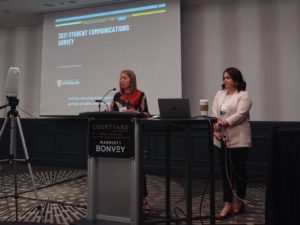PSE marcomm conference calls for student-led engagement
By Nathan Lemay | June 9, 2022

Trying to connect with one another during a time of online classes, mask mandates and social distancing created a need for innovative student engagement in higher education. Communicators and marketers have faced a unique challenge to engaging online or hybrid students, as some of them explained at last week’s 6th Annual Marketing & Communications for Post Secondary Conference.
Hosted in Toronto by Summers Direct Conference & Events and Swansea Communications and chaired and co-sponsored by Sharon Aschaiek of Higher Ed Communications, the conference yielded a key insight: student-generated content and input from student surveys offer ways to build meaningful engagement with this key stakeholder group.
Student communication preferences at the University of Waterloo
Student communications preferences were collected by the University of Waterloo in its 2021 Student Communications Survey, which was conducted as a follow-up to similar surveys from 2013, 2015 and 2019. During their session, Jenn Willoughby, associate director of integrated communications, and Claire Taylor, manager of student engagement and strategic communications, discussed their comparison of student input during the pandemic to previous years.
“Be mindful that the communications landscape changes, people’s preferences change, your campus will change,” Taylor said. “So be open to adapting.”
Highlights from their survey comparison included that email is the preferred way for students to receive information, especially about tuition and fees, academic information, awards and funding, but they want fewer emails in general—concise and relevant content is king. Social media has its place, too, with Instagram, Facebook and Reddit as the top channels for sharing information about campus events for all students, or those specific to their faculty, program or major, as well as urgent campus updates.
Overall, Willoughby and Taylor found that it’s important for communicators to be consistent but adaptable while remaining approachable. Even something as simple as directly using “you” instead of “students” in communications creates the perception that the university is demonstrating care and concern.
Fraser International College’s resilient communications and community

Fraser International College typically welcomes students from more than 70 countries to Burnaby, British Columbia to complete the equivalent of their first year of university, but the uncertainty these international registrants typically experience was multiplied by the pandemic. This created a stronger need for the institution to meaningfully connect with both prospective and current students, and its solution involved using student-led content and engagement.
Jessica Truong, student experience coordinator, and Rodrigo Garcia-Rojas Villegas, associate director of digital recruitment, discussed the results of FIC’s student-centered and student-led social media campaigns during their presentation, “Developing communications resiliency in remote engagement.” Focusing on communications and community, they demonstrated that they weren’t afraid to tap into the student population and find great ambassadors for the institution. By cultivating student leaders and empowering them with higher levels of responsibility, such as handing over social accounts to peer educators and their “ask an advisor” Instagram campaign, they successfully developed trust and online community in a remote learning environment.
“It was nerve-wracking because I handed over the entire channel to this dedicated group of [student] volunteers,” says Truong. “This one Instagram channel that we utilized is for branding, marketing, retention purposes—it was for everything. If there was one misstep it comes back to how the school is represented.”
Truong built trust with student volunteers so that they could host their own Instagram Live sessions, which she felt was one of the best things to witness at the start of the pandemic.
“It really showed that this student community still wanted to engage with each other, they didn’t want to give up just because the world was changing and we were all sitting at home,” she explained. “They still wanted to show ‘Hey, we’re still here to support you, please come engage with us because we want to engage with you.'”
After remote instruction was figured out, FIC’s priority was to connect and engage with their student population, making sure they knew that support and community was still available. By coordinating content “for students by students,” FIC avoided gatekeeping and maximized the impact of their overall content while making genuine connections with their student audience.
The University of Waterloo’s first virtual campus tour
The pandemic sped up the rise of virtual campus tours, and they’re not dropping out of sight anytime soon, so it’s important for communicators to involve the student perspective in their planning and execution. During their presentation, “Back to the online drawing board: reimagining Waterloo’s virtual campus tour,” Pamela Hurvid, campus engagement specialist, and Chantel Franklin, manager of marketing and campus engagement, describe their design (and redesign) of the University of Waterloo’s initial virtual tour.
Their tips included involving student perspectives in initial working groups, incorporating interactive video content created by student ambassadors, and using survey data to create a high-quality virtual tour. When asked, “Overall, how would you rate your experience on the Waterloo virtual campus tour?” in 2020/2021, 29% of student respondents said they were “very satisfied” and 62% said they were “satisfied.” Compared to 60% responding “very satisfied” and 35% responding “satisfied” with the 2022 version of the tour, their approach seems to be working. You can read more about their process here.